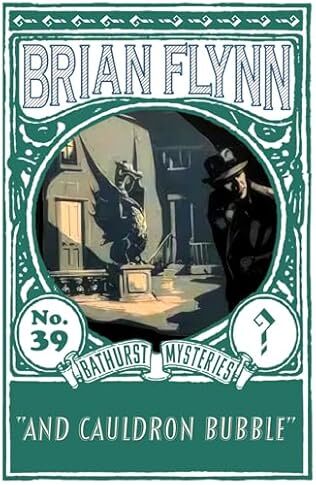And Cauldron Bubble

A review of And Cauldron Bubble by Brian Flynn – 250824
Double, double, toil and trouble. The thirty-ninth in Flynn’s Anthony Bathurst series, originally published in 1951 and the fourth in the batch of five recently reissued by Dean Street Press, takes its title from the famous witches’ scene in Macbeth. Set in Quinster and, principally, in the Red Deer where mine host is John Melville, it concerns the mystery surrounding the fates of two his regular diners, Lady Blanchflower and Mrs Whitburn.
After their usual meal, Mrs Whitburn escorts Lady Blanchflower, as is their custom, back to her quarters in the cloisters of Quinster Castle. The following morning Lady Blanchflower is found having been strangled with pair of silk stockings, there is no trace of Mrs Whitburn, and, curiously, there is a man’s wig underneath her ladyship’s body. At the insistence of the fourteenth Duke of Quinster, horrified that such an outrage should occur within his walls and to such a distinguished woman, Scotland Yard are called in and, naturally, MacMorran, with the assistance of one Anthony Bathurst, are allocated the case.
Bathurst is far from the epitome of the infallible amateur sleuth here. He blunders around trying to make sense of what on the face of it a bewildering crime with no obvious motive and with circumstantial evidence pointing in the direction of Mrs Whitburn. He, though, is convinced that Mrs Whitburn is as much a victim of the murderer as Lady Blanchflower and in his desperation to find her body, he prevails upon the local force to rake through the ashes of the Quinster bonfire. No remains of a charred body are found, but the remnants of a second wig are discovered.
Undaunted, Bathurst’s keen eyes find an earring in the grounds of the Castle and his attention is then drawn to the large heap of manure there. Of course, the body of Mrs Whitburn is found there. But who was the murderer and why? There are some important clues scattered around the story including a slip of paper found amongst Mrs Whitburn’s possessions bearing a seemingly cryptic message, a large framed photograph of an Ascot party from 1939 hanging in the Red Deer, a cheque for the deposit for two wigs which bears a date several days before the decision was made to hire them, the import of each of which Bathurst only realises as the race to solve the mystery reaches its final furlong.
As a murder mystery it would be difficult to argue convincingly that this falls into the fair play category. We only stumble across the real motivation and then, by inference, the probable identity of the culprit when Bathurst does as the requisite information only emerges late in the day. Like MacMorran and Bathurst up to that point the reader is intrigued by the mystery but perplexed as to how it is all going to pan out. At the end, it is a case very much of crossing the Ts.
It would not be a Flynn without a large dollop of sport, Mrs Whitburn’s son being the Kent cricket captain, K M R Whitburn, and the story revolves around a substantial betting coup, the knowledge of which has deadly consequences.
While the story, I thought, was the weakest of the latest reissues I have read, there is still much to admire. Perruquier is a glorious word to roll around the tongue and casus Bella was a pun that brought a smile to my face. Coram publico gets another outing, this time in connection with coughing rather than swearing, and descendent of Nimshi was an inventive euphemism that tested my knowledge of the Old Testament.
And there were some wonderful similes. In describing the inarticulacy of Bella who is unable to provide any coherent evidence, she is compared to “a Christmas walnut that by cunning positioning on the dish, survives the Yuletide feast and comes up for judgment when the fat has left the land somewhere about Shrove Tuesday”.
Flynn’s style is florid and playful, having great fun, for example, with the names of some of his characters like Bullwinkle. “The winkle, Anthony thought, had superseded the bull” only for later “the winkle had gone – the bull was back”. There is more than a touch of humour. “Anthony’s spine-ice turned from semi-liquid to berg” and after a dawning revelation “the spine-berg seemed a trifle less weighty”.
It is great fun if you are prepared to stay the course and have your money on the nose!
My thanks to Victoria Eade for a review copy.



